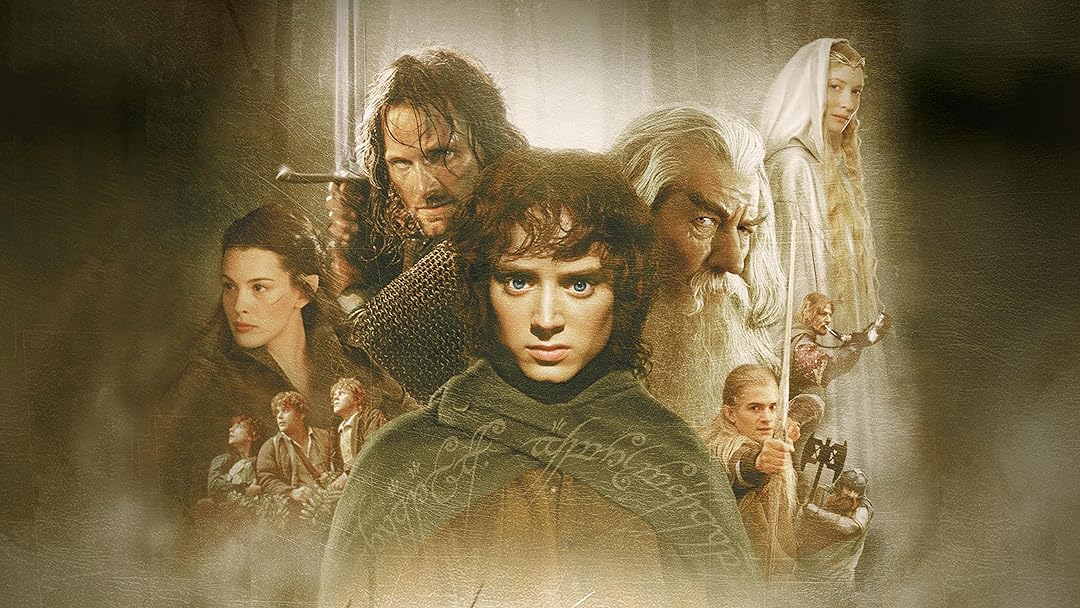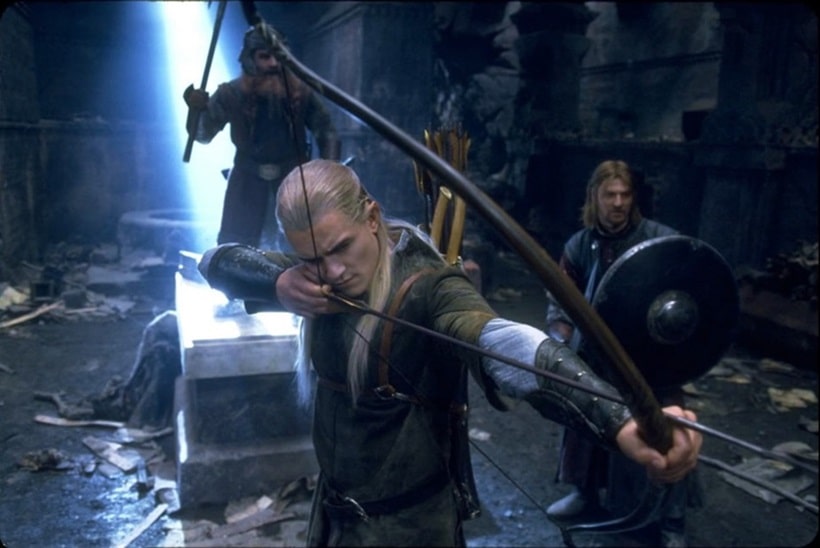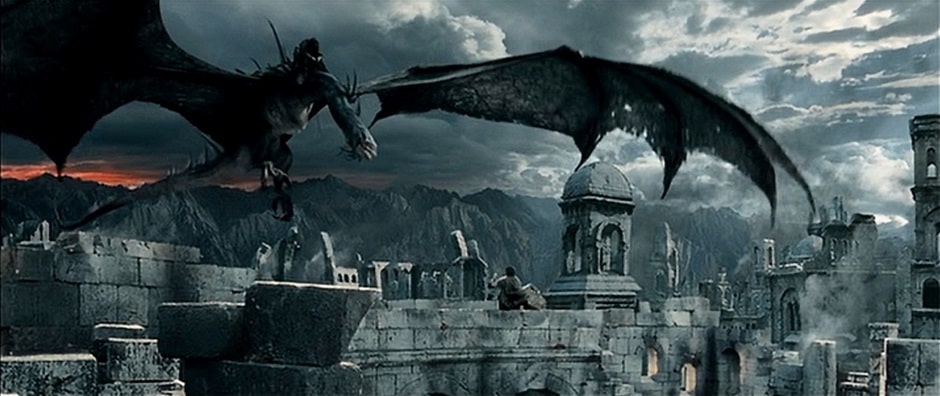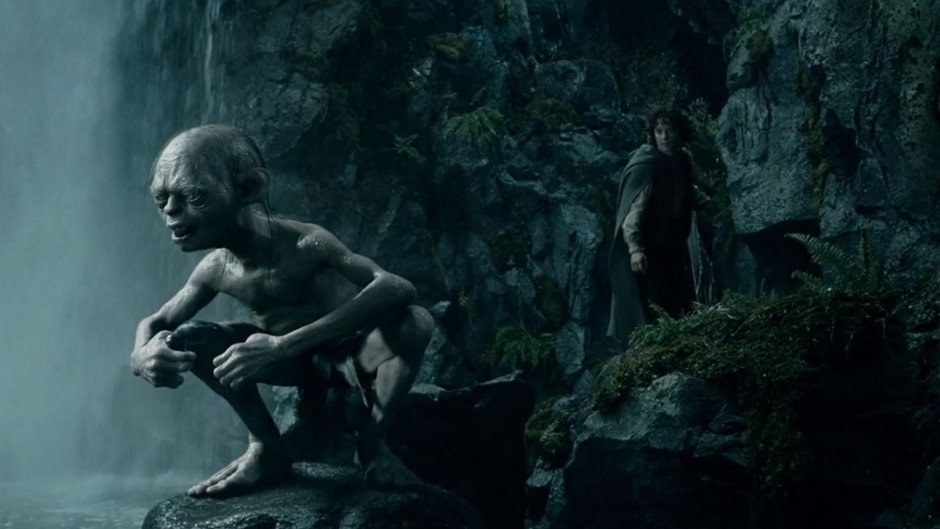Ellsworth’s Cinema of Swords: Peter Jackson’s Lord of the Rings: Two-Thirds of a Miracle
The Fellowship of the Ring (New Line Cinema, December 2001)
Some of us waited a very long time for these movies — or at least, that’s how it felt. I grew up in the 1960s reading science fiction and fantasy; my father had read pulps like Weird Tales back in the ‘30s, and when those stories were republished as postwar paperbacks, he bought them and then passed them on to me. But I discovered Tolkien’s Lord of the Rings trilogy on my own in my junior high school library, which had pristine copies of the Houghton Mifflin hardcovers with those two-color foldout maps bound into the endpapers. I can still picture exactly where those volumes stood on those library shelves. I read them cover to cover… and then I read them again. When Dungeons & Dragons came along a few years later, giving us all the ability to tell such stories to ourselves, the course of my life was set. And here I am, 55 years after pulling The Fellowship of the Ring down from that shelf, still telling stories of heroic fantasy — and writing about them also, it seems.
So, to those of us who grew up treading in our imaginations the weed-grown paths of Middle-earth, a world to us almost as real as that of the asphalt roads and concrete pavement where we led our physical lives, the gift of Peter Jackson’s Fellowship of the Ring and The Two Towers was unexpected and kind of a miracle. Jackson was one of us, he saw the same visions we did, and he had the talent and drive to put them on the screen, in a depiction as vivid and real as what we saw in our minds when we read the works of J.R.R. Tolkien. And if that act of respectful and dedicated creation isn’t inspiring, I don’t know what would be.
The Lord of the Rings 1: The Fellowship of the Ring
Rating: ***** (Essential)
Origin: New Zealand/USA, 2001
Director: Peter Jackson
Source: New Line DVD
This landmark film has become a cultural touchstone, and there’s no point in giving it regular coverage here because it’s almost inconceivable that anyone reading this review hasn’t seen it. But we can go into its cinematic swordplay and edged-weapon combat, because there are several interesting things to say about that.
In his LotR trilogy, Peter Jackson set out to bring Tolkien’s world of Middle-earth to life, approaching it as far more than a generic fantasy, giving the films the context and depth of the author’s richly imagined story setting. To accomplish that, one of the things Jackson did was to hire Tony Wolf, an expert in various pre-modern martial arts, to act as the “cultural fighting styles designer” on the trilogy. Wolf studied each major fantasy culture depicted in the films — Elves, Goblins, Dwarves, the Men of Gondor and Rohan, and the Uruk-hai Orcs — and considered, not just their combatants’ arms and armor, meticulously designed in Jackson’s prop workshops, but the societies they came from and how those origins shaped their approach to combat. For each culture, Wolf invented a particular fighting style, based in part on historical models but not beholden to our world’s history.
And then Wolf personally and painstakingly trained the actors representing each culture’s warriors on how to fight to best represent their particular fantasy. He did this with the lead actors, but also, and perhaps most importantly, with the extras playing the parts of Middle-earth’s rank and file soldiers. Moreover, he didn’t teach them just how to wield their weapons in a particular style, but also to adopt certain postures and silhouettes, to stand and move like warriors of the cultures they represented, both alone and in combat order with their cohorts. This brings to each of Middle-earth’s martial races a distinctive behavior and a remarkable specificity — one would be tempted to use the word “authenticity” if it wasn’t such an astounding exercise in, well, deliberate inauthenticity.
The other aspect that makes the best fight scenes in Fellowship so hard-hitting and memorable is the way the action is filmed and then treated. These aren’t the human-scaled sword duels of historical adventures, the kind of scraps fight director William Hobbs did so well, these are fantasy combats between larger-than-life opponents whose capabilities transcend the merely human. To convey this, every fight is a careful mix of grounded, realistic moves that flow naturally into exaggeration, superhuman dodges and attacks that make the larger-than-life actions convincing. Moreover, movement speed changes smoothly from slow-motion, for clarity in setting up positioning and attacks, directly into sped-up fast-motion to convey more-than-human power, reflexes, and speed.
This is particularly clear in the movie’s best action scene, the attack of the Goblins and the cave troll on the Fellowship in Balin’s tomb. The speed changes almost frame-to-frame to give the combat both physical impact and emotional resonance — as examples, the blinding speed of Legolas’ archery, and the slo-mo on Frodo’s agonized facial expressions after he’s wounded. Most crucially, the effect is applied with a light hand, subtly — you might not even notice it if you weren’t looking for it, you just sense that this fight feels really intense. Yet Jackson holds back and never lets the speed changes make the action cartoonish.
This speed-change technique has its roots in Asian martial arts movies — and if you want to see how bad it can look when it’s overdone, there are plenty of examples there. But in Fellowship of the Ring, Jackson shows himself to have a masterful grasp of modern action filmmaking. (That is, when he doesn’t forgo restraint and go totally over the top: I’m looking at you, 2005’s King Kong.)
The Lord of the Rings 2: The Two Towers
Rating: ***** (Essential)
Origin: New Zealand/USA, 2002
Director: Peter Jackson
Source: New Line DVD
CGI special effects — computer graphics — had been used in fantasy films for some time, mainly in a targeted way to bring specific creatures to life, such as the dragons in Dragonslayer (1981) and DragonHeart (1996), and the cave troll in the first Lord of the Rings film, Fellowship of the Ring. But it was in Peter Jackson’s second Tolkien epic, The Two Towers, that seamless use of CGI was first used on a massive scale to bring an entire fantasy world into visual reality.
This triumphantly persuasive technology is at the forefront from the film’s very first scene, the flashback and continuation of Gandalf’s fight with the Balrog, and computer-rendered imagery is worked into most of the major scenes to follow, depicting Middle-earth’s Ents, Goblin Warg-riders, Oliphants, trolls at the Black Gate, and the reptilian flying mounts of the Nazgûl. And in the Battle of Helm’s Deep, groups of soldiers are multiplied into entire armies through technical wizardry.
The greatest achievement is certainly the rendering of Gollum, an entire main character with more screen time than many of the live-action cast, a combination of motion-captured performance by Andy Serkis melded with a computer-animated nonhuman model. It’s masterful, completely convincing while avoiding uncanny-valley creepiness.
The biggest problem with CGI in fantasy films is when it’s over-used, and the world it’s depicting loses its connection to the real world, becoming a sort of hyper-realistic cartoon. Fortunately, in The Two Towers, Jackson keeps Middle-earth grounded in the reality of our own world — something he failed to do in the final two Hobbit movies, but more of that anon.
In The Two Towers, the armies of the tyrant Sauron begin to march on civilization, making this heroic fantasy very much a war movie. Jackson expertly portrays the movement and clash of armies by switching between the points of view of the soldiers on the ground and a sort of omniscient aerial “battle-cam” that makes the progress of the battles clear. Triumphalist heroics are certainly on display, but the film doesn’t shy away from showing the stakes of the war and its costs, with moving scenes of ordinary people whose lives are threatened or destroyed.
But despite all the build-up to and emphasis on the great Battle of Helm’s Deep, the most exciting and effective fight in The Two Towers is a mere skirmish, the clash between Aragorn (Viggo Mortensen) and the Riders of Rohan versus a troop of Goblins riding Wargs, giant CGI-rendered hyena-wolf mounts. There are only two dozen lives at stake here, instead of thousands, so the life of every soldier on either side is suddenly important, even precious, and often snuffed out with shocking speed. It’s a short fight, five minutes tops, but the seamless mix of CGI and live-action footage is masterfully choreographed, perfectly timed, and unforgettable in its impact.
(We’ll save The Return of the King for another day.)
Where can I watch these movies? I’m glad you asked! Many movies and TV shows are available on disk in DVD or Blu-ray formats, but nowadays we live in a new world of streaming services, more every month it seems. However, it can be hard to find what content will stream in your location, since the market is evolving and global services are a patchwork quilt of rights and availability. I recommend JustWatch.com, a search engine that scans streaming services to find the title of your choice. Give it a try. And if you have a better alternative, let us know.
Previous installments in the Cinema of Swords include:
Zatoichi at Large
Invitation to a Keelhauling
Sequel Debacle
Deuces Wild
Beware of Greeks
Peak ‘90s Wuxia
Ashes of Time
Consider the Rapier
They Seek Him Here…
The Darkness Before the Dawn
Young Horatio Hornblower
LAWRENCE ELLSWORTH is busily promoting the Cinema of Swords compilation from Applause Books that was born right here at Black Gate! The volume out now covers swordplay movies up through the ‘80s, but Ellsworth is continuing with new material for a Volume Two and is now working his way up through the 2000s. These later reviews are being published weekly on his new Cinema of Swords Substack blog, at cinemaofswords.substack.com.
Meanwhile, Ellsworth soldiers on at his mega-project of editing and translating new, contemporary English editions of all the works in Alexandre Dumas’s Musketeers Cycle; the seventh volume, Court of Daggers, is available now as an ebook or trade paperback from Amazon, while the eighth, Shadow of the Bastille, is being published in weekly installments at musketeerscycle.substack.com. His website is swashbucklingadventure.net. Check them out!
(Ellsworth’s secret identity is game designer LAWRENCE SCHICK, who’s been designing role-playing games since the 1970s. He now lives in Dublin, Ireland, and is Principal Narrative Designer for the Dungeons & Dragons videogame Baldur’s Gate 3.)




The fight in Two Towers against the Warg riders is an exciting and well-crafted scene just considered in isolation, but I kind of hate it in the context of the film as a whole; _especially_ the whole “Oh, noes, Aragorn has Fallen From A Cliff and is totally, really and truly Dead!” conclusion.
(PJ, for all his strengths as a filmmaker, has a distressing tendency to inject entirely unneeded melodrama into his films — the way he really, really leans into Frodo getting stabbed by the cave troll being another example.)
Having said all of which, I do really enjoy the films as a whole and think they’re the best adaptation we’re likely to get at this point. (Unlike the Hobbit movies.)
Excellent points.
Someone–it may have been you, Ellsworth– mentioned that the first Dungeons and Dragons movie came out like a year before TFOTR and as the D&D movie looked so bad and did so poorly, the people funding TFOTR must have been a little worried.
I have quibbles with the movies – who wouldn’t? (My biggest is the omission, in Return, of Frodo saying of Gollum that Gandalf was right; Gollum had a part to play when he – Frodo – couldn’t have destroyed the Ring, so “let us forgive him!” Would have taken twenty seconds and it’s literally THE MORAL OF THE WORK!) Overall, though, Jackson did an admirable job with an incredibly difficult, complex task. All honor to him and all those who gave us these movies.
And then Jackson largely threw away that honor with the naked cash-grab of the Hobbit trilogy. It was as fatal an error as Isildur keeping the Ring instead of destroying it.
Fine comments Thomas (and I especially appreciate your point about the moral of the book not making it into the movie, which I think is very insightful), but I have to disagree with your dis against the Hobbit movies.
Jackson didn’t throw anything away by making the Hobbit trilogy. His first three movies stand untarnished and inviolate.
But more importantly I think, people forget that the audience was clamoring for these films. There was enormous interest in them when they were announced. Tolkien purists like you and me rolled our eyes at the thought of that poor book being stretched into a trilogy…. but my kids (who’ve never read the books) LOVED THEM.
Film is a business, and New Line Cinema took an existential risk when they funded the first three films, giving them to a talented but relatively unproven name like Jackson. If they’d failed, it would have destroyed New Line. The Hobbit trilogy rewarded them handsomely for the incredibly gutsy creative gamble that gave fantasy its finest cinematic jewel. I think there’s very little doubt that the money that flowed as a result enabled producers to green-light risky genre properties for the next two decades — all the way down to the new Dune films, I believe.
The Hobbit films aren’t my cup of tea. But I’m very glad they exist, I’m glad they were so successful, and I’m glad Peter Jackson made them. After the success of the first three films, It was going to be someone, and I think Jackson achieved a number of truly memorable moments in the middle of a cheerfully — celebratory! — overblown Hollywood production.
Take your bow, New Line and Peter Jackson. You earned the right to do this, and you earned the rich rewards it brought.
I couldn’t be happier with Jackson’s trilogy.
The Sword of Shannara has been my favorite single fantasy novel since I read it maybe forty (?) years ago.
And after a couple decades of nothing, instead of even a cool animated movie, I was treated to an MTV series aimed at…I don’t know: teens, or twenty-somethings. The guy who played Allanon wasn’t bad, but it was a two-season piece of crap, which Terry Brooks supposedly was involved with. He totally took the money and sold out his second nove: The Elftones. The old PC game was better than the streaming series.
Wheel of Time has been pretty good through two seasons. Ring of Power was expensive fan fiction garbage.
Jackson did for LotRT what David Suchet did for Hercule Poirot, and Maury Chaykin did for Nero Wolfe.
(I’d mention Jeremy Brett, but there have been a lot of good Holmes’, including Basil Rathbone as a long-time standard)
We got a legitimately definitive LotR (we’ll leave his Hobbit out of this discussion). He did as well putting Tolkien on screen as anyone is likely to. I’m happy about that.
I walked out of the first movie when Arwen was substituted for Glorfindal. I could accept cutting things—the Old Forest, Tom Bombadil, the Barrow Downs—but not changing things. I walked out of the second movie when the elves arrived at Helm’s Deep. I never saw the third one.
[…] (Black Gate): Some of us waited a very long time for these movies — or at least, that’s how it felt. I grew […]